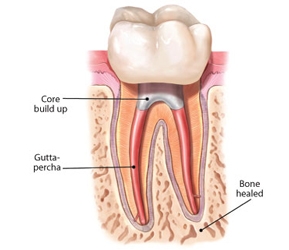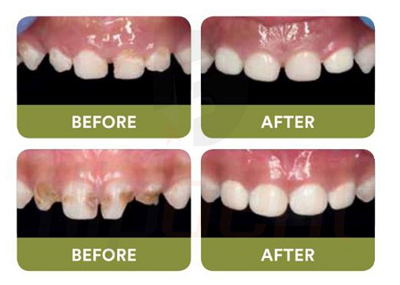Root canal is a treatment to repair and save a badly damaged or infected tooth instead of removing it.
Our teeth have an enamel layer on the outside, a second layer of dentine, and a soft inside core that extends into the root in our jaw bone. The core contains the dental pulp, which consists of nerves, blood vessels and connective tissue. When the decay gets into the soft core, the pulp can become infected or inflamed. A root canal is needed to clean out the decay. The root canal treatment leaves the natural tooth in place and prevents further decay.
Signs & Symptoms that you may need a Root Canal:
- Severe pain.
- Sensitivity when biting or pressing on the tooth.
- Prolonged sensitivity (Pain) to Hot or Cold temperatures. (After the heat or cold has been removed).
- Discoloration or Darkening of the tooth.
- Swollen gums / darkening of the gums / Bumps on the gums / Tender gums.
- Cracks in the teeth.
Steps in Root Canal Therapy
Creating the Access Cavity:-
Gaining access to the infected pulp and create a way to remove the infected pulp tissue by making a hole in the enamel & dentin till the pulp chamber so that the infected pulp can be removed. This access cavity exposes the roof of the pulp chamber which gets perforated to make a direct passage to pulp of the tooth.

Measuring the canal length of the tooth:-
To measure canal length so that correct length of canal files can be used to prepare and widen the root canal . The calculation of the root length carried out using X-ray.
Cleaning & Shaping the Root canal followed by tooth irrigation:-
- To facilitate cleaning.
- Provide space for placing the sealing materials.
- To maintain or develop a continuously tapering funnel from the canal orifice to apex.
Files, Reamers and Protapers are used to make canals more accessible.
- Shaping of the canal is carried out to widen the canal, so that the infected pulp tissue can be removed.
- Irrigating solutions can be injected into the canal to carry out disinfection. Commonly used irrigating solution in the sodium hypo chlorite (NAOCL) to cleanse the entire pulp chamber by killing the micro organisms.
Sealing the Tooth:-
Packing the cleaned canal with sealing materials, which are inert, non allergic & disinfectant. Most commonly used sealing material is “Gutta Percha”. It comes in preformed cones whose sizes exactly match the dimensions of the root canal. Sealing material is compacted by using manual pressure and heat. The idea is to completely seal the pulp chamber and the canal leaving no space. Gutta Percha is inert in nature and does not promote growth of microbes on it.

Now by the end of the root canal treatment, the infected pulp tissues have been removed completely, that means all the nerve fibers that causing pain are now removed. The empty pulp chamber and the root canals are completely filled with sealing materials that fills the space and stops any chance of further infection.
The final stage of root canal includes restoring of the tooth. This is done by placing a crown, a realistic looking artificial tooth which is made of gold, porcelain or porcelain fused to metal.

Single sitting rct—it can be done when patient in need of no time and when the pulp is not too much infected.
Post and core rct-
This would be done for in the case the tooth structure is grossly damaged and if the tooth need to get restructured for cown placement.
V Dental Hospitals have experienced doctors, Dr Anita Madugula & Dr John Madugula who would deal the cases with lot of patience & make patient comfortable.


